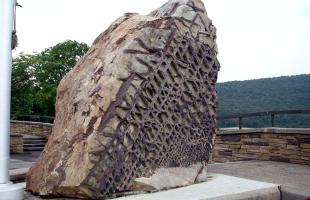Copy Link
Add to Bookmark
Report
AIList Digest Volume 6 Issue 059

AIList Digest Tuesday, 29 Mar 1988 Volume 6 : Issue 59
Today's Topics:
Queries - Control of Batch Reactors & DEFT Project &
AI in CAD & Conversational Programs & Expert Systems,n
AI Tools - POPLOG Availability in the US &
Parallel Inference Mechanism & TI microExplorer,
Project - Cognitive Agent
----------------------------------------------------------------------
Date: Fri, 25 Mar 88 12:17:28 IST
From: Oren Regev <CERRLOR%TECHNION.BITNET@CUNYVM.CUNY.EDU>
Subject: Re: AI in ISRAEL
HELLO!
WE ARE DEALING HERE IN THE I.I.T (ISRAEL INSTITUTE OF TECHNOLOGY)
IN IMPLIMENTATION OF EXPERT SYSTEMS ON THE CONTROL OF BATCH REACTORS.
THIS IS DONE BY BUILDING A RULE BASE AND CONNECTING IT TO A SIMULATOR
BASED ON A MODEL OF SUCH A SYSTEM.
THE CONTROL OF SUCH A REACTOR IS SO HARD BECAUSE OF INTERNAL HEAT
GENERATION DURING REACTION (IT IS EXOTHERMIC REACTION).
WE ARE INTERESTED IN ANY INFORMATION THAT YOU CAN SEND US
OREN REGEV chemical engineering faculty CERRLOR AT TECHNION
------------------------------
Date: 24 Mar 88 15:42:09 GMT
From: ucsdhub!hp-sdd!ncr-sd!rb-dc1!tjeff@sdcsvax.ucsd.edu (Jeff
Enderwick)
Subject: DEFT
Does anyone know of any ref's for IBM's DEFT project (Diagnostic
expert system for disk drives) ?
Thanks - Jeff
sdcsvax!ncr-sd!rb-dc1!tjeff
^
|
sdcsvax.UCSD.EDU
------------------------------
Date: 25 Mar 88 12:28:32 GMT
From: mcvax!unido!infko!uro@uunet.uu.net (Uwe und Roland)
Subject: need info on AI in CAD
In doing research on intelligent CAD-systems, I'm looking
for literature, technical/research reports and conference
proceedings on following topics:
- Architecture of intelligent CAD-systems
- Design and Implementation of AI-models which enable
the user to include structural knowledge (i.e. design knowledge),
exceeding topological knowledge while describing his objects to the
CAD-system. I'm looking for a kind of shell, surrounding the realization
of the topological/geometrical model, but beeing as independent
as possible from the latter one.
- Applications of results of neural-network research
in the construction of CAD-systems
Does anybody know, whether there are "intelligent" CAD-systems
already available for "real-life" applications?
--
Roland Berling, Uni Koblenz (EWH), Informatik
Rheinau 3-4, D-5400 Koblenz (West Germany)
UUCP: ..!unido!infko!uro uro@infko.UUCP
------------------------------
Date: 25 Mar 88 21:29:41 GMT
From: ok2@psuvm.bitnet
Subject: conversations?
Hi, I'm trying to locate versions of PARRY and similar programs that
simulate conversation with a human being (such as ELIZA and SHRDLU).
I do know that PARRY, which simulates conversing with a Paranoid person
was written by K.M. Colby, based on the information processing approach
(of a paranoiac) of S.S. Tomkins.
Also, I know that SHRDLU, which simulates talking to and giving orders
to a robot in a computer generated simulation, was written by Terry Winograd.
Both PARRY and ELIZA take advantage of the tactic of predefining the
context of the conversation (a conversation with a paranoiac, or conversation
with a therapist) to imply real meaning to sentences the program generates from
key words picked from the human's sentences.
SHRDLU on the other hand is using an internal model of the 'world' which
the simulated 'robot' is in. The program is limited to talking about the
actions of the robot in this simulated world....
Any information about where to find copies of these programs (for IBMpc,
Apple, or VMS) or about programs like these (or better than them...) will be
greatly appreciated.
Steven
"To err is human, but when the eraser wears out before the pencil,
you're overdoing it" - from Soundingboard
------------------------------
Date: Fri, 25 Mar 88 09:40:17 EDT
From: CMSBE1%EOVUOV11.BITNET@CUNYVM.CUNY.EDU
Subject: Please, send me information about...
Date: 25 March 1988, 09:26:16 EDT
From: Juan Francisco Suarez Vicente (KIKO) CMSBE1 at EOVUOV11
To: AILIST-REQUEST at KL.SRI
Hi from Spain !!!
Could anyone send me (via electronic mail) any of these informations:
- plausible reasoning and certainty factors
- knowledge adquisition in medical diagnosis
- improving diagnostics obtained using certainty factors
- more medical knowledge representations than typical rule-based systems ?
Thanks a lot in advancing to all answers. If there is no people who
had this electronic information, I'm looking for bibliography too.
Please, send your mail for AILIST distribution, or directly to:
CMSBE1@EOVUOV11 (EARN network)
------------------------------
Date: Fri, 25 Mar 88 09:15:58 GMT
From: Aaron Sloman <aarons%cvaxa.sussex.ac.uk@NSS.Cs.Ucl.AC.UK>
Subject: request for information about POPLOG
>From: uazchem!dolata@arizona.edu (Dolata)
>Subject: POPLOG availability in the US
>Can someone give me a pointer to the party who distributes POPLOG in the
>US? Since my net connections are a bit rocky, could you send me both
>email and US Snail mail addresses?? (Phone number?)
This news item has not reached me direct. Someone forwarded it without
the Snail mail address. So I thought I should reply both direct and
via AI Digest.
POPLOG is developed by the School of Cognitive Sciences at Sussex
University, Brighton, England and distributed world wide by Systems
Designers. However we have an arrangement with Prof Robin Popplestone
at Univ. Amherst Mass to distribute it at a much reduced price to
academics in US and Canada.
He can also arrange for provision of evaluation licences, provide
demonstrations, etc. It is now possible to have ML in Poplog though it
is not yet part of the official release.
US Contact addresses for POPLOG:
For Academic enquiries/sales in USA and Canada
Prof Robin Popplestone
Dept. of Computer and Information Science
Lederle Graduate Research Center
University of Massachusetts
Amherst, MA 01003, USA
Email pop@cs.umass.edu
or
Prof Robin Popplestone
Computable Functions Inc.,
35 South Orchard Drive,
Amherst, MA 01002, USA Phone(413) 253-7637
For non-academic enquiries/sales
Systems Designers International Inc
Industrial Division
New Castle Corporate Commons,
55 Read's Way,
New Castle,
Delaware 19720, USA
Phone (302) 323 1900 (800)888-9988
I hope that helps.
Aaron Sloman,
School of Cognitive Sciences, Univ of Sussex, Brighton, BN1 9QN, England
ARPANET : aarons%uk.ac.sussex.cvaxa@nss.cs.ucl.ac.uk
aarons%uk.ac.sussex.cvaxa%nss.cs.ucl.ac.uk@relay.cs.net
BITNET: aarons%uk.ac.sussex.cvaxa@uk.ac
As a last resort (it costs us more...)
UUCP: ...mcvax!ukc!cvaxa!aarons
Phone: University +(44)-(0)273-678294 (Direct line. Diverts to secretary)
------------------------------
Date: 25 Mar 88 19:01:46 GMT
From: nau%frabjous@mimsy.umd.edu (Dana Nau)
Reply-to: nau@frabjous.UUCP (Dana Nau)
Subject: Re: POPLOG availability in the US
In article <8803210643.AA02468@uazchem.SGI> dolata@uazchem.UUCP (Dolata)
writes:
>Can someone give me a pointer to the party who distributes POPLOG in the
>US? Since my net connections are a bit rocky, could you send me both
>email and US Snail mail addresses?? (Phone number?) Thanks for the help.
Why don't you get in touch with Robin Popplestone, the author? He's in the
department of Computer and Info. Science at UMass; I think his e-mail address
is pop@cs.umass.edu.
Dana S. Nau ARPA & CSNet: nau@mimsy.umd.edu
Computer Sci. Dept., U. of Maryland UUCP: ...!{allegra,uunet}!mimsy!nau
College Park, MD 20742 Telephone: (301) 454-7932
------------------------------
Date: 24 Mar 88 20:03:32 GMT
From: maui!leon@locus.ucla.edu (Leon Alkalaj)
Subject: Re: parallel inference mechanism
There are (at least) two reports from ICOT on the KABU-WAKE method
for parallel inference:
TM-0131, july 1985: A New Parallel Inference Mechanism Based
on Sequential Processing,
Y. Sohma, K. Satoh, K. Kumon, H. Masuzawa and A. Itashiki.
TR-150, March 1986: KABU-WAKE: A New Parallel Inference Method and
Its Evaluation,
K. Kumon, H. Masuzawa, A. Itashiki, K. Satoh and Y. Sohma.
Leon Alkalaj,
UCLA Computer Science Dept.
------------------------------
Date: 25 Mar 88 23:58:22 GMT
From: voder!apple!striepe@ucbvax.Berkeley.EDU (Harald Striepe)
Subject: Re: TI microExplorer (Mac II coprocessor) ...
In article <1180@kodak.UUCP> luciw@kodak.UUCP (bill luciw) writes:
>Well, our KBS Lab is ordering a microExplorer, the coprocessor for the Mac II.
>1) What impact (if any) does the alledged lack of "true" DMA have on the
>paging performance of the microExplorer?
I do not have exact figures on this, but overall performance is 50% + of TI's
Explorer II; contributors to this differential are reduced clock speed of the
CPU to reduce power consumption, different memory organization (cache), and
disk performance. However, it is nice to have a single file system rather
than dealing with multiple partitions.
>2) Is TI's implementation of RPC available to other applications (such as those
>developed under MPW)?
Texas Instruments is publishing the RPC spec.
>3) How well integrated is the microExplorer into the rest of the Mac
>environment - (cut, copy, paste, print on an AppleTalk printer) ?
The microExplorer uses the Apple peripheral devices. Although the user
interface integration is not yet complete (you are running an Explorer window
system in one or more Macintosh windows under MultiFinder), TI is working
agressively on deeper integration.
>4) Can you install the "load bands" on third party disks (SuperMac 150) or do
>they need to remain on the Apple hard disk (the load bands are supposed to be
>normal, finder accessible files)?
Although we have not tried this, there should be no reason why this should not
work (a Macintosh volume is a Macintosh volume).
>5) How much of a hassle is it to port applications over to the little beastie
>from a normal Explorer (what about ART, KEE, SIMKIT, etc.)?
Some vendors have installed their application in less than a day. Inference,
IntelliCorp and Carnegie Group all announced support of the microExplorer.
>6) Do any benchmarks (ala Gabriel) exist for this machine?
You might want to contact TI, they ran a whole suite. Unfortunately, I do not
have the details.
>7) How about ToolBox access from the Lisp Environment? (or am I dreaming?)
Not available in the first release, but a kit is planned. Since RPC is public,
you would have to "roll your own" in the meantime. Another approach would be
to use Coral's Allegro CL on the Macintosh side, implement the RPC, and...
>Thankyou in advance for all your comments and I will post our experiences
>(good or bad, of course) as they develop ...
Although the microExplorer is supported by TI, we all would be interested
in hearing about your experiences, and definitely would be willing to help
you reach the right people, should you run into unforeseen problems in getting
help.
--
Harald Striepe
Business Development Manager, Artificial Intelligence
Apple Computer, Inc.
email: striepe@APPLE.COM AppleLink: STRIEPE2
------------------------------
Date: 25 Mar 88 14:57:47 GMT
From: sunybcs!nobody@rutgers.edu
Reply-to: sunybcs!rapaport@rutgers.edu (William J. Rapaport)
Subject: Re: Software Wanted to Build a Mind
In article <8803250637.AA22481@ucbvax.Berkeley.EDU> POPX@VAX.OXFORD.AC.UK
writes:
> SOFTWARE WANTED
> -
> TO BUILD A MIND
You might be interested in the following document, excerpts of which
follow; the full document is available by contacting us.
William J. Rapaport
Assistant Professor
Dept. of Computer Science||internet: rapaport@cs.buffalo.edu
SUNY Buffalo ||bitnet: rapaport@sunybcs.bitnet
Buffalo, NY 14260 ||uucp: {ames,boulder,decvax,rutgers}!sunybcs!rapaport
(716) 636-3193, 3180 ||
DEVELOPMENT OF A COMPUTATIONAL COGNITIVE AGENT
Stuart C. Shapiro, Director
William J. Rapaport, Associate Director
SNePS Research Group
Department of Computer Science
SUNY at Buffalo
226 Bell Hall
Buffalo, NY 14260
shapiro@cs.buffalo.edu, rapaport@cs.buffalo.edu
OVERVIEW.
The long term goal of the SNePS Research Group is to understand the
nature of intelligent cognitive processes by developing and experiment-
ing with a computational cognitive agent that will be able to use and
understand natural language, and will be able to reason and solve prob-
lems in a wide variety of domains.
...
ACCOMPLISHMENTS.
In pursuit of our long term goals, we have developed:
(1) The SNePS Semantic Network Processing System, a knowledge-
representation/reasoning system that allows one to design, imple-
ment, and use specific knowledge representation constructs, and
which easily supports nested beliefs, meta-knowledge, and meta-
reasoning.
(2) SNIP, the SNePS Inference Package, which interprets rules
represented in SNePS, performing bi-directional inference, a mix-
ture of forward chaining and backward chaining which focuses its
attention on the topic at hand. SNIP can make use of universal,
existential, and numerical quantifiers, and a specially-designed
set of propositional connectives that include both true negation
and negation-by-failure.
(3) Path-Based Inference, a very general method of defining inheri-
tance rules by specifying that the existence of an arc in a SNePS
network may be inferred from the existence of a path of arcs
specified by a sentence of a ``path language'' defined by a regu-
lar grammar. Path-based reasoning is fully integrated into SNIP.
(4) SNeBR, the SNePS Belief Revision system, based on SWM, the only
extant, worked-out logic of assumption-based belief revision.
(5) A Generalized Augmented Transition Network interpreter/compiler
that allows the specification and use of a combined parsing-
generation grammar, which can be used to parse a natural-language
sentence into a SNePS network, generate a natural-language sen-
tence from a SNePS network, and perform any needed reasoning
along the way.
(6) A theory of Fully Intensional Knowledge Representation, according
to which we are developing knowledge representation constructs
and grammars for the Computational Cognitive Mind. This theory
also affects the development of successive versions of SNePS and
SNIP. For instance, the insight we developed into the inten-
sional nature of rule variables led us to design a restricted
form of unification that cuts down on the search space generated
by SNIP during reasoning.
(7) CASSIE, the Computational Cognitive Mind we are developing and
experimenting with, successive versions of which represent an
integration of all our current work.
CURRENT RESEARCH.
Current projects being carried out by various members of the SNePS
Research Group, some joint with other researchers, include:
(1) VMES, the Versatile Maintenance Expert System:
...
(2) Discussing and Using Plans:
...
(3) Intelligent Multi-Media Interfaces:
...
(4) Cognitive and Computer Systems for Understanding Narrative Text:
...
(5) The Representation of Natural Category Systems and Their Role in
Natural-Language Processing:
...
(6) Belief Representation, Discourse Analysis, and Reference in Nar-
rative:
...
(7) Understanding Pictures with Captions:
...
BIBLIOGRAPHY.
A bibliography of over 90 published articles, technical reports, and
technical notes may be obtained from Mrs. Lynda Spahr, at the address
given above, or by electronic mail to spahr@gort.cs.buffalo.edu.
------------------------------
End of AIList Digest
********************























